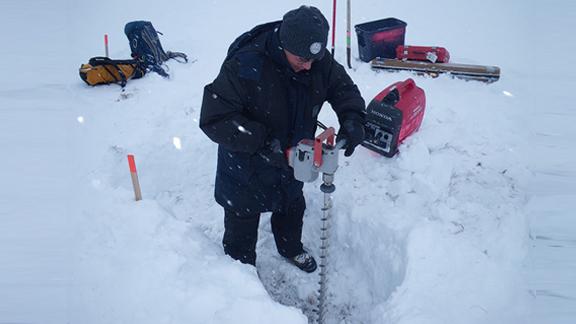
To enhance Earth system models, researchers are examining how and why permafrost thaws and melts.
Snowy peaks rise up in one direction; boggy tundra spreads across the other. Fuzzy heads of long-stemmed plants sway in the wind, interspersed with bog blueberries. This is Alaska's Eight Mile Lake, where the nearest town has a population of just over a thousand people.
Researchers supported by the Department of Energy's Office of Science are visiting here and other remote locations to study how permafrost – soil that's frozen for consecutive multiple years – thaws. Because soils in high latitude systems where this happens store almost twice as much carbon as the entire atmosphere, figuring out the thawing process is essential to modeling terrestrial ecosystems and climate. Improving Earth system models can help scientists better understand the likely extent and effects of future climate change.
The Earth's Freezer
Permafrost's deep layers act like the world's ice chest, locking away organic matter such as dead plants and animals from degradation for thousands of years. The cold temperatures and waterlogged soil slows decomposition to a near halt.
But today the Arctic is warming at a pace that hasn't occurred for the past three million years. Rising at a rate twice as fast as the rest of Earth, the Arctic's average temperature could increase by as much as 14○ F between 2081 and 2100.
This warming could cause permafrost to thaw much faster and more extensively than ever before. Depending on the rate and extent of climate change, the Arctic could lose 30 to 70 percent of its permafrost in the next century.
Organic matter in thawed permafrost can decompose rapidly. As bacteria, fungi, and other tiny organisms break down the matter, they release the greenhouse gases carbon dioxide and methane. Every 1 degree C (1.8 degree F) increase in average global temperatures could result in permafrost thawing enough that it releases a year-and-a-half's worth of human-made carbon dioxide emissions. Greenhouse gases from the thawed permafrost would lead to more climate change, which then could lead to more permafrost thawing – a self-reinforcing cycle.
"This is the most important tipping point," said Jizhong Zhou, a researcher at Lawrence Berkeley National Laboratory (LBNL) and professor at the University of Oklahoma
A Rewarding Collaboration
While researchers understand why permafrost is important, many questions remain unanswered. Even models that have in-depth information about land, ocean, and atmospheric processes lack enough detail about the Arctic.
That's where field and laboratory research come in. Before 2012, permafrost researchers and climate modelers usually worked separately. But through the Next-Generation Ecosystem Experiments Arctic (NGEE Arctic) project, teams from DOE headquarters, DOE national laboratories, and universities brought together field, laboratory, and modeling researchers to share their needs and expertise.
"This is a level of dynamics and interactions that we just haven't had in the past," said Stan Wullschleger, NGEE Arctic director and a researcher at Oak Ridge National Laboratory. "[These collaborations] make for a much more informed, richer discussion about how field, laboratory, and modeling scientists can interact."
Research in a Brutal Landscape
Studying permafrost is far from easy. When temperatures plummet more than 20 degrees below zero, wires become so brittle that a mere jostle cracks them. Because short winter days render solar panels useless, researchers must haul around car-sized batteries to power their instruments. But the essential data these studies provide make it all worthwhile.
One major type of field study allows scientists to investigate how temperature affects the rate of thawing. To simulate how a permafrost ecosystem would react to both warmer summers and winters, researchers create ecosystem in miniature. To mimic summer conditions, they use open-topped greenhouses that warm the air. For winter conditions, they set up fences where snow piles up, warming the ground like a comforter insulating a bed.
While it seems as if summer would affect permafrost the most, it's actually winter warming that causes thawing. One major studyExternal link supported by the Office of Science found that although summer conditions didn't warm the soil, winter warming increased soil temperatures by 3-5○ F. After only three years, these changes led to a 45 percent increase in respiration, the process that produces carbon dioxide. There were some increases in plant growth and uptake of carbon dioxide, but it wasn't nearly enough to offset the releases.
Changes in water movement also could accelerate thawing. Currently, wedges of ice make up one-fifth of the upper layer of permafrost. These ice wedges are so foundational to the landscape that when they melt, the ground actually collapses. The resulting shifts can connect troughs and lakes so much that they drain out, transforming the ecosystem's water distribution.
A study by NGEE ArcticExternal link found that temperature increases of as little as 9○ F can cause ice wedges to cave in within 15 to 20 years. And they don't have to be changes in average temperature – an unusually hot summer can kick-start the process.
"It's a transformation that's not easily undone. Certainly not in our lifetime," said Sue Natali, a permafrost researcher at Woods Hole Research Center.
Read more at - https://www.energy.gov/science/articles/defrosting-world-s-freezer-thawing-permafrost

